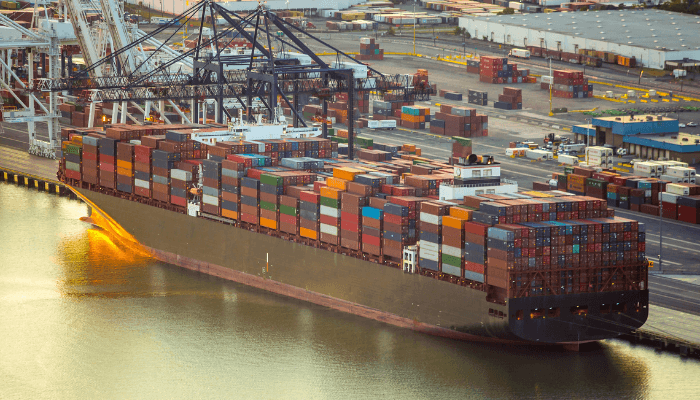Minimum Quantity Commitment (MQC) and Liquidated Damages in Container Shipping: Concept and Relevance
Generally, in the container shipping industry, shippers and cargo owners work with container carriers either through long-term contracts or on an ad hoc basis. The former involves signing contracts for a longer time frame (typical duration being one year, but sometimes could be shorter or multi-year contracts as well), while in the latter instance, shippers play the spot market.
While spot rates are generally commonly preferred when markets are bearish, and so shippers try to play the spot market in the anticipation that freight rates fall further in the future (closer to the cargo readiness date), entering into a contractual agreement is a feasible option for shippers with a regular flow of volumes and when markets are stable or where supply chain reliability and availability of space and equipment is prioritised over freight rates (unless the difference between spot and contract rates is excessively high).
The very essence of a contract between a carrier and a shipper is the agreement to carry a certain volume of cargo at agreed freight rates. This specified quantity of cargo constitutes the shipper’s commitment to the carrier in return for competitive contract rates (which are lower than the prevailing spot rates) and is known as the Minimum Quantity Commitment (MQC).
The MQC clause in the contract thus specifies the minimum quantity of cargo (or the number of containers) that the shipper is obligated to transport with the carrier during the duration of the contract in return for the lower contractual freight rates.
Entering into a contractual agreement with an MQC is beneficial to the shipper in the following ways:
1) Guaranteed space and equipment: The entire premise of entering a contract with MQCs is to ensure that the carrier promises space to carry the committed volumes. This provides shippers with certainty regarding the availability of space on vessels and equipment.
2) Stability in freight rates: As rates are negotiated for the entire duration of the contract (and can not be revised, except in the case of force majeure events or contingencies), shippers are assured of stability in freight rates, resulting in relatively steady overall transport costs. This enables shippers to budget supply chain costs accurately and price their merchandise accordingly.
3) Limited exposure to increases in accessorials and surcharges: Contractual agreements generally specify the quantum of surcharges, such as the Bunker Adjustment Factor (BAF) or Terminal Handling Charge (THC), which limits the shipper’s exposure in case of a rise in the carrier’s costs related to the activities that the surcharges pertain to. For example, in the case of Terminal Handling Charges (THC), where carriers sometimes mark up the quantum, the carrier might agree to a lower THC in the contract.
Similarly, BAF levels fluctuate depending on oil/ bunker prices, which generally move upwards (except during times of recession), wherefore most contracts specify that the BAF levied will be revised in case oil prices move beyond a certain range. This implies that the carrier will absorb minor increases in bunker costs (while also retaining the option of correcting the quantum of the BAF if excessive price movements result in an inordinately higher increase in bunker costs), which, to a great extent, insulates the shipper from BAF increases.
4) Optimising inventory management: With guaranteed space, shippers have confidence regarding the volume, frequency, and speed at which they will be able to deliver raw materials, components, and finished goods to their manufacturing plants or consumer markets. As a result thereof, shippers can plan their inventory levels, reorder levels, and minimum reorder quantities accordingly to avoid storing surplus inventory or ordering more (or earlier) than is necessary to replenish stocks. This lowers inventory holding costs and improves cash flows while also minimising risks of obsolescence and damage to stock. This also helps shippers in striking the right balance between the JIT (Just in Time) and JIC (Just in Case) methods of inventory management.
5) Supply chain reliability: All of the above factors greatly aid end-to-end supply chain planning, with minimal disruptions and a lower probability of errors. Shippers have more control over their supply chains and can forecast costs and delivery schedules with greater accuracy, making the supply chain more reliable and robust. This results in overall benefits for the business and can be a source of competitive advantage.
From the Carrier’s perspective
For the carrier, contractual MQC cargo represents guaranteed business and space utilisation, while the spot market represents opportunities to maximise revenues and yields.
MQC volumes thus ensure an acceptable minimum level of space utilisation and provide revenue visibility to carriers, leaving them well poised to aggressively sell their remaining open space in the spot market.
MQC volumes can also help carriers in network optimisation and CAPEX allocation.
Carriers, therefore, strive to strike a balance between ensuring adequate cargo commitments, while leaving enough space to cater to spot cargo.
The intent is to ensure that the MQC justifies the contractual rates offered and that the aggregate revenue is of a level sufficient enough to make it financially feasible for the carrier.
Liquidated Damages
The concept of MQCs is linked to Liquidated Damages, which is the penalty that the shipper has to pay in case of inability to deliver the committed volumes. Liquidated damages are charged as a certain pre-agreed amount per container, so the total amount the shipper is liable to pay as liquidated damages is calculated as the shortfall in MQC multiplied by the rate of liquated damages.
The rationale behind incorporating the liquidated damages clause is to have in place a deterrent to discourage shippers from promising unrealistically high volumes in return for lower freight rates while also compensating the carrier for the opportunity cost of the blocked space that was eventually unutilised due to the shipper’s inability to deliver the committed volumes.
In practice, however, the enforcement of liquidated damages and holding the shipper accountable for missing MQCs largely depends on the extent of the shortfall, the market conditions, and the relative bargaining power of shippers vis-a-vis carriers.
Where the shortfall is not very high, or where market conditions are bearish with shippers holding the upper hand or where retaining the shipper’s business is crucial for the carrier, it is likely that the carrier will overlook the shortfall.
In a buoyant bull market and high freight rate environment (such as was witnessed in post-Covid, in 2021 and 2023), carriers would be more amenable to overlooking MQC shortfalls, as it allows them to sell the space thus freed at the higher spot market rates and maximise revenue (as had the shipper delivered the MQC volumes, the carrier would have been legally obligated to carry them at the agreed freight rates, thus decreasing space available for higher-yielding spot cargo).
Factors to consider while determining MQC’s
It is important for both the shipper and the carrier to ensure that the MQCs agreed upon are realistic. Contractual freight rates are offered by the carrier depending on the volumes committed by the shipper (amongst other factors) and, therefore, place a legal obligation upon both the shipper (to ensure that the volumes materialise) and the carrier (to ensure adequate space and equipment to cater to the MQC volumes).
Some important factors to consider while determining the MQC are explained below:
1) Overall business or volumes controlled by the Shipper: The shipper needs to evaluate his production capacity and export potential before he can commit to an MQC with the carrier. The volume has to be large enough to induce the Carrier to offer lucrative rates, while the Shipper could look to spread his volumes amongst two or more carriers in order to avoid risks arising from excessive reliance on one carrier.
2) Capacity and Trade lanes or Port corridors involved: The carrier needs to analyse their shipping network and available capacity before agreeing to the MQC volumes. This is both to ensure that the carrier has the capacity to cater to the MQCs and also to ensure that the freight rates are priced with the market conditions, equipment availability, and supply-demand imbalance in mind.
3) Market Outlook: Depending on whether freight rates are expected to fall or rise during the duration of the contract period, carriers and shippers will try to minimise risks. If freight rates are forecast to increase, shippers will attempt to set a higher MQC to ensure that a greater proportion of their cargo moves at the pre-agreed contract rates. On the contrary, if rates are expected to fall, then shippers will try to lower their commitment (sufficient to ensure adequate inventory levels) in the hope of later capitalising on lower spot rates prevailing closer to the cargo readiness date.
Carriers will likewise take into consideration freight rate forecasts and overall business outlook while accepting MQCs and try to negotiate rates and contract duration accordingly.
To illustrate with an example, when freight rates were at record high levels post-COVID, carriers such as Maersk adopted an innovative approach to maximising long-term profitability by compelling shippers to sign long-term contracts (with duration ranging from two to three years). The underlying logic was that the contractual rates offered, though lower than the existing spot rates, were higher than the average contractual rates.
This meant that the carrier would benefit from higher contract rates even when the spot freight market eventually reverted to normalcy. The success of this strategy can be gauged from the fact that this strategy enabled Maersk Line to shore up their revenues even in H2 2022 and 2023, when spot rates had started returning to their historical average levels.
4) Seasonality and Peak season: Demand spikes during peak season (such as Christmas or prior to Chinese New Year), and on account of commodity-specific seasonality (such as grapes or mangoes) needs to be taken into account while deciding MQC volumes. Both shippers and carriers need to understand the implications and constraints that these periodic demand spikes entail and evaluate feasibility prior to committing.
Conclusion
It is thus obvious that MQCs are an important aspect of the contractual agreement between carriers and shippers, which enable carriers to quote freight rates commensurate with the volumes committed, while shippers can, in turn, rest assured about space and equipment availability for the MQC volumes.
The sanctity of the MQC volumes is sometimes disregarded due to commercial pressures and extant market conditions, but they remain an integral part of contractual terms and conditions.
Given the widespread volatility in international transport markets, MQCs will continue to play an increasingly important role in helping shippers plan their supply chains, while for carriers, it will help plan their capacity allocation and design commercial strategies.
You might also like to read-
- How to Take Care of Cargo on Container Ships at Sea?
- 15 Reasons For Commoditisation Of The Container Shipping Industry
- 17 Benefits Of Using Logistics Technology Solutions To Customers And Supply Chains
- Trends and Outlook for Container Shipping Industry in 2024
- Commoditisation of Container Shipping: Implications for Carriers and Cargo owners
Disclaimer: The author’s views expressed in this article do not necessarily reflect the views of Marine Insight. Data and charts, if used in the article, have been sourced from available information and have not been authenticated by any statutory authority. The author and Marine Insight do not claim it to be accurate nor accept any responsibility for the same. The views constitute only the opinions and do not constitute any guidelines or recommendations on any course of action to be followed by the reader.
The article or images cannot be reproduced, copied, shared or used in any form without the permission of the author and Marine Insight.
Do you have info to share with us ? Suggest a correction

About Author
Jitendra has over 20 years of international experience in the Container Shipping, Ports and Logistics industry, spanning 3 diverse geographies, wherein he has been involved in the commercial and strategic aspects of the container business.
Latest Maritime law Articles You Would Like:
Latest News
- What are Logistics Risks?
- How Port and Terminal Operators Can Control Emissions?
- Minimum Quantity Commitment (MQC) and Liquidated Damages in Container Shipping: Concept and Relevance
- The Essential Guide to Shipping Container Dimensions – What You Need to Know
- A Comprehensive Overview of IMDG Code for Shipping Dangerous Goods
- Nautical Law: What is UNCLOS?
Subscribe To Our Newsletters
By subscribing, you agree to our Privacy Policy and may receive occasional deal communications; you can unsubscribe anytime.
Web Stories


























